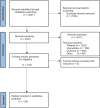Systematic review of craniofacial osteosarcoma regarding different clinical, therapeutic and prognostic parameters
- PMID: 37035145
- PMCID: PMC10080080
- DOI: 10.3389/fonc.2023.1006622
Systematic review of craniofacial osteosarcoma regarding different clinical, therapeutic and prognostic parameters
Abstract
Background: Osteosarcomas are the most common primary bone tumor while occurrence in the craniofacial skeleton is relatively rare. There are clinical differences of osteosarcomas regarding their location. In this regard craniofacial osteosarcomas (COS) have special characteristics. Extracranial osteosarcomas (EOS) occur mainly in the long bones of the extremities (tibia, humerus and femur). These tumors metastasize hematogenically at a very early stage. In comparison, COS are mainly localized in the mandible and maxilla, occur later in life and show significantly less and later metastasis and respond differently to adjuvant therapy. In the literature, clinical characteristics of COS and EOS are rarely compared directly. The aim of this systematic review is to answer the question whether COS and EOS exhibit fundamentally different clinical behavior and how they differ in terms of survival rates and response to different therapies.
Methods: A systemic review was performed. Pubmed, Cochrane and Google Scholar were used as search engines. The literature research was done by using clearly defined terms and their links. 124 full texts were selected and evaluated for this review. The inclusion criteria were determined using the PICO model.
Results: COS have significantly better survival rates, especially if they are located in the jawbone. Surgical R0 resection is crucial for therapeutic success. The study situation regarding the benefit of neoadjuvant chemotherapy in COS is very inhomogeneous. There is also no evidence for the benefit of adjuvant radio- or chemotherapy in COS. The large heterogeneity of the studies in terms of therapeutic concept, initial situation of the patients and outcome considered, as well as the small number of patients with craniofacial osteosarcoma were limiting factors.
Conclusion: The results of this study show the clear therapeutic and prognostic differences between COS and EOS and underline the necessity to consider both types of osteosarcoma as independent tumor entities in future studies. Furthermore, the study highlights the importance of surgical R0 resection for the prognosis of COS patients. There is no evidence for therapeutic benefit of adjuvant/neoadjuvant radio-/chemotherapy in R0 resected COS cases.
Keywords: chemotherapy; craniofacial osteosarcoma; extracranial osteosarcoma; head and neck osteosarcoma; maxillofacial bone sarcoma; radiotherapy; surgical therapy; survival.
Copyright © 2023 Weber, Stigler, Lutz, Kesting and Weber.
Conflict of interest statement
The authors declare that the research was conducted in the absence of any commercial or financial relationships that could be construed as a potential conflict of interest.
Figures
Similar articles
-
Craniofacial Osteosarcoma-Pilot Study on the Expression of Osteobiologic Characteristics and Hypothesis on Metastasis.Front Oncol. 2020 Jun 23;10:745. doi: 10.3389/fonc.2020.00745. eCollection 2020. Front Oncol. 2020. PMID: 32656074 Free PMC article.
-
Clinical features and overall survival of osteosarcoma of the mandible.Int J Oral Maxillofac Surg. 2023 May;52(5):524-530. doi: 10.1016/j.ijom.2022.10.005. Epub 2022 Oct 13. Int J Oral Maxillofac Surg. 2023. PMID: 36243646
-
Chondroblastic osteosarcoma of maxilla: a case report and review of literature.J Maxillofac Oral Surg. 2009 Sep;8(3):290-3. doi: 10.1007/s12663-009-0071-2. Epub 2009 Nov 21. J Maxillofac Oral Surg. 2009. PMID: 23139529 Free PMC article.
-
Limb-salvage surgery offers better five-year survival rate than amputation in patients with limb osteosarcoma treated with neoadjuvant chemotherapy. A systematic review and meta-analysis.J Bone Oncol. 2020 Sep 15;25:100319. doi: 10.1016/j.jbo.2020.100319. eCollection 2020 Dec. J Bone Oncol. 2020. PMID: 33088699 Free PMC article. Review.
-
Primary osteosarcoma of the head and neck in pediatric patients: a clinicopathologic study of 22 cases with a review of the literature.Cancer. 2001 Feb 1;91(3):598-605. Cancer. 2001. PMID: 11169944 Review.
Cited by
-
Skull Base Osteosarcoma: An Analysis of 9 Cases and Literature Review.Head Neck Pathol. 2025 May 15;19(1):64. doi: 10.1007/s12105-025-01801-2. Head Neck Pathol. 2025. PMID: 40374813 Review.
-
MTA2 knockdown suppresses human osteosarcoma metastasis by inhibiting uPA expression.Aging (Albany NY). 2024 Sep 6;16(17):12239-12251. doi: 10.18632/aging.206070. Epub 2024 Sep 6. Aging (Albany NY). 2024. PMID: 39248711 Free PMC article.
-
Clinical and radiographic characteristics of osteosarcomas of the jaws: A retrospective study.J Clin Exp Dent. 2024 Aug 1;16(8):e998-e1003. doi: 10.4317/jced.61827. eCollection 2024 Aug. J Clin Exp Dent. 2024. PMID: 39281792 Free PMC article.
References
Publication types
LinkOut - more resources
Full Text Sources



